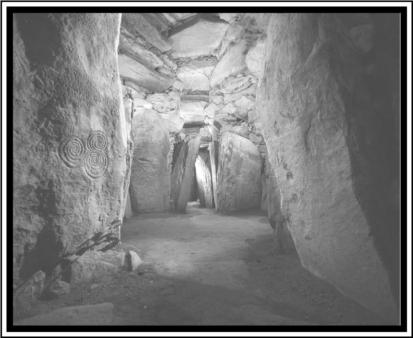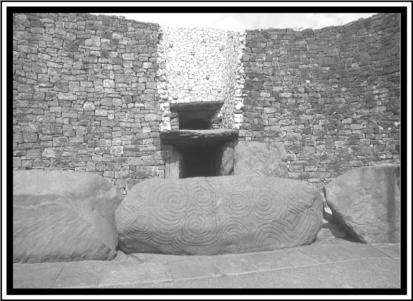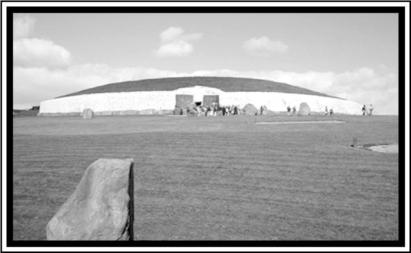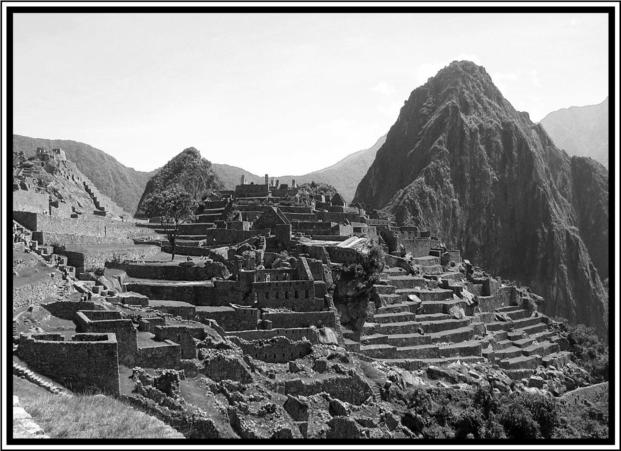Hidden History: Lost Civilizations, Secret Knowledge, and Ancient Mysteries (18 page)
Read Hidden History: Lost Civilizations, Secret Knowledge, and Ancient Mysteries Online
Authors: Brian Haughton
Tags: #Fringe Science, #Gnostic Dementia, #U.S.A., #Alternative History, #Amazon.com, #Retail, #Archaeology, #History


© Government of Ireland
Interior of the monument, showing
megalithic art.
It has been estimated that the
Newgrange Passage Tomb contains
around 200,000 tons of material and
would have taken 300 workers a minimum of 20 to 30 years to construct.
Rounded stones from the River Boyne
were used in the construction, but the
white quartz pebbles used as facing
stones come from the Wicklow Mountains, 50 miles away, and were probably brought by boat down the Boyne. The large slabs of rock which make up
the walls and ceiling of the passageway were probably transported on
wooden rollers from a quarry 8.7 miles
away. This huge investment in time
and labor indicates a socially advanced
and well-organized people, as well as
a society of superb craftsmen.
The Passage Graves of Newgrange,
Knowth, and Dowth are justly famous
for their wealth of megalithic (c. 4500
B.c.-1500 B.C.) rock art. In fact, Knowth
alone contains a quarter of all the
known megalithic art in Europe. At
Newgrange, several of the stones inside the monument are decorated with
spiral patterns and cup and ring marks,
as are some of the kerbstones. Many of
these stones are carved on their hidden sides so as not to be visible to anyone in the tomb. But the most
spectacular piece of megalithic art is
on the superb slab lying outside the
entrance to the tomb. This recumbent
stone is profusely decorated with lozenge motifs and one of the few known
examples of a triple spiral, the other
two examples being inside the monument. Such motifs are found on stones
in other passage tombs on the Isle of
Man and the island of Anglesey in North
Wales. Although these motifs were also
used in later Celtic art, it is not known
what they represent, though perhaps
they recorded astronomical and cosmological observations.
Surrounding the Newgrange
mound is a ring of 12 upright stones
up to 8 feet in height. Originally, there
were perhaps around 35 of these
standing stones, but they have been
removed or destroyed over time. Representing the final building stage at
the site, the circle was erected around
2000 B.C., long after the great passage
tomb had gone out of use, although its
presence shows that the area itself still
retained some importance for the local population, perhaps connected with
astronomy or ancestor worship.
Newgrange is perhaps most famous
for a spectacular phenomena that occurs at the site every year for a few
days around the 21st or 22nd of December. The entrance to the Newgrange
passage tomb consists of a doorway
composed of two standing stones and
a horizontal lintel. Above the doorway
is an aperture known as the roof box
or light box. Every year, shortly after
9 a.m. (on the morning of the winter
solstice, the shortest day of the year)
the sun begins its ascent across the
Boyne Valley over a hill known locally
as Red Mountain, the name probably
taken from the color of the sunrise on
this day. The newly risen sun then
sends a shaft of sunlight directly
through the Newgrange light box,
which penetrates down the passageway as a narrow beam of light illuminating the central chamber at the back
of the tomb. After just 17 minutes the
beam of light narrows and the chamber is once more left in darkness.
This spectacular event was not rediscovered until 1967 by Professor
Michael J. O'Kelly, though it had been
known about in local folklore before
that time. Newgrange is one of only
three known sites with such light
boxes, the other two being Cairn G, at
Carrowkeel Megalithic Cemetery,
County Sligo, Ireland, and the passage
tomb at Bryn Celli Ddu on Anglesey,
North Wales. There may possibly be a
fourth, at a chambered tomb at Crantit
on the island of Orkney, Scotland, discovered in 1998, but this is still disputed. Newgrange, however, is by far the best constructed and the most complex of these sites, and reveals in spectacular fashion the highly developed
knowledge of surveying and astronomy possessed by the Neolithic
inhabitants of the area. It also illustrates that for the people who aligned
their monument with the winter
solstice, the sun must have formed
an important part of their religious
beliefs.

© Government of Ireland
Entrance to Newgrange with huge
entrance slab displaying megalithic art.
One major aspect of the Newgrange
monument-which is often disputedis its primary function. Excavations
inside the chambers revealed relatively few archaeological finds, probably because the majority had been
removed in the centuries that the site
remained open (from 1699 until it was
examined by O'Kelly in 1962). Finds
included two inhumation burials and
at least three cremated bodies, all of
which were found close to the huge
stone basins, which seem to have been
used for holding the bones of the dead.
Taking into account the removal
of much of the material and the fact
that all of the human bones recovered
were small fragments, thus making it
difficult to clearly identify individual
burials, there must have been a lot
more than five people originally buried in the chambers. Archaeological
finds inside the monument have not
been spectacular; though a few gold
objects have been found, including two
gold torcs (a piece of jewelry worn
about the neck similar to a collar), a
gold chain, and two rings. Other finds
include a large phallus-like stone, a
few pendants and beads, a bone chisel,
and several bone pins. The lack of pottery finds at Newgrange is typical for
passage grave cemeteries, which seem
to have been places reserved for certain types of activity and an extremely
limited number of people. However, not
everyone agrees that Newgrange ever
functioned as a tomb at all. In his 2004
book, Newgrange-Temple to Life,
South African-born author Chris
O'Callaghan argues against Newgrange
being a Passage Grave. He maintains
that there is no real evidence of intentional human burial at Newgrange,
and believes that the bone fragments
found during excavations were probably brought in there by animals long
after Newgrange became disused.
O'Callaghan's theory is that the
monument was built to celebrate the
union of the Sun God with Mother
Earth, a symbol of the life force itself.
The light box or sun window would
have allowed the Sun God to penetrate
the passage of the mound (signifying
Mother Earth) and reach deep into the
chamber (symbolizing the womb). This
theory is borne out in part by the winter solstice alignment of the site, and
perhaps by the phallic shaped pillar
and chalk balls found in the chamber,
which possibly represented male sexual organs. However, Newgrange
does not need to be confined to one
function. And, as pointed out above,
the small amount of human bone discovered at the site does not seem to
represent the total of Neolithic burials within the chambers, as significant
amounts were probably taken out of
the monument, perhaps by scavenging
animals or people looking for relics.
Newgrange has many connections with
Irish myth, and was known as a sidhe
or fairy mound even into the 20th century. A number of illustrious characters from Irish mythology are
mentioned in association with it, including the Tuatha De Danann, the ancient mythical rulers of Ireland;
Aengus Og, its traditional owner; and
the hero Cuchulainn. Various mythical interpretations of Newgrange have
been put forward. These include that
it functioned as a house of the dead,
the passage and chambers being kept
dry for the comfort of the indwelling
spirits, and the roof box being opened
and closed to let the spirits in and out
of the tomb. It was also thought to be
the dwelling place of the great god
Dagda, and at specific times during the
year valuable offerings would be made
to such gods. There is actually archaeological evidence for offerings at
Newgrange long after it ceased to function as a tomb and observatory. Various Roman items, including gold coins,
pendants, and brooches-some in mint
condition-have been found at the
monument. Considering the Romans
never invaded Ireland, many of these
offerings must have been made by Romans or Romano-British visitors from
Britain, perhaps they were ancient pilgrims venerating an already 3,000-
year-old religious monument.

© Government of Ireland
The monument, as seen from a distance.
In 1993, due to their vast cultural
and historical importance, Newgrange
and the nearby passage tombs of
Knowth and Dowth were designated a
World Heritage Site by UNESCO.
Newgrange now attracts in excess of
200,000 visitors per year, all of which
come on guided tours from the Bru na
Boinne Visitor Center, as there is no
longer direct access to the site. Anyone
wanting to visit around the 21st of December to witness the magnificent midwinter solstice may, however, be in for
a long wait. In 2005 there were around
27,000 applications to enter the tomb
at this time. Consequently, admission
to the Newgrange tomb chamber for
the winter solstice sunrise is only by
lottery. It is necessary to fill out an
application form, available at the reception desk in the Bru na Boinne
Visitor Center, and in early October,
50 names are drawn, 10 for each
morning the tomb is illuminated. Two
places in the chamber are then given
to each of the lucky people whose
names are drawn. One can only wonder how the Neolithic peoples of the
area chose their watchers of the midwinter solstice at this magnificent
site.


©John Griffiths.
Overall view of Machu Picchu in its stunning setting.
